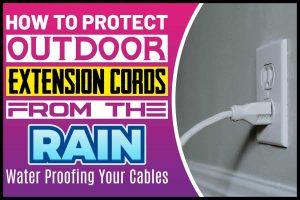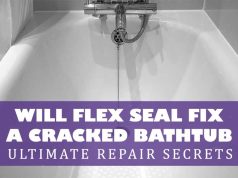Dealing with electricity has always been a risky matter when in a house where it is dry. This risk only worsens when you connect the cables outside the home, especially during the rainy season.
Water is not something you want to get into your power cables since it will undoubtedly cause a short circuit.
So how can you stop rainwater from getting into your outdoor extension cords? Let us peel back the covers and solve this problem;
How to Protect Outdoor Extension Cords From the Rain
You need to keep all the water away from your extension cord since water conducts electricity. This means that a current could get in the water and hurt anyone that touches it or fry your equipment along with the extension cord.
The best thing to do is get an extension cord that is rated for outdoor use. Such a cord will have a waterproof jacket designed to keep the water out, so you don’t have to worry about the cord.
The biggest concern is the connectors or any points that you can plug appliances into. For the connectors, you can use a Cord dome.
The dome is a simple product you can get in your local hardware store, and it is specifically designed for this. It has a bottom and top half that have a space in between them.
You can fit your connectors inside the dome then tighten its cap in place, and it will protect the connections from the rain and splashes from the ground. It is flexible to allow the cables to come out without bending too hard.
In addition to all these, you can add a power stripe and have multiple cords coming into the same dome.
Inside the dome, you will see some holes for spikes. These holes allow you to secure the dome on the ground, preventing it from getting lifted by water or strong winds.
This addition is an excellent way to keep your appliances safe for sure, but there are other hacks you can use to go about this problem.
Other Hacks To Keep The Rain Out
You cannot allow the rain to stop your work, so what will you do when it’s about to rain? There are some hacks apart from professional ways of preventing rainwater from getting to your extension cords.
You can use pallet wrapping plastic for small connectors. This wrap is easy to find and cheap, but it is a sure way to cover up your equipment.
Take the wrap around the joint as tightly as possible, making sure there are no spaces. You could also use two buckets to keep the water away.
Turn one bucket over and up the connectors on top of it. Insert the second bucket upside down over the first one so that the cables are inside it.
You can add some rocks around it to give it extra support so that the rain doesn’t flip it over. This trick is not the best way to go about it, but it’s an improvisation that will help you if the rain gets you unprepared.
How To Know A Cable’s Intended Use
Every electrician and website will tell you to choose a cable meant for what you want to use it for.
But how do you know what a line was designed for? This is essential information that you need before you go to the store to buy an extension cord.
The jacket determines the environment in which you can use a cord since it is the outer shell of the cable. Each jacket has a letter designation, and this letter should tell you what the cord was made for as follows;
- S is the designation for flexible cords that are meant for general home use. They can’t withstand extremes, be it temperature, voltage, or weather. These are not approved for outdoor use.
- W is used on cables meant for general uses, but they have been designed to withstand the weather. Thus you can use them outdoors.
- J is used on cables with standard 300V insulation. The absence of J means that you can use the cord for heavier jobs since it has 600V insulation.
- P indicates that the extension cord uses parallel wire constructions, and it is best for household extension cords and air conditioners.
- T implies that the jacket is vinyl thermoplastic which allows it to withstand a considerable amount of temperature.
- E indicates that the cord’s jacket is made of thermoplastic elastomer rubber, making it more flexible and durable than most. Such a cable will be a good choice for long-distance connections that might have a lot of bends.
- O indicates that the extension cord is oil resistant which can be a reasonable assurance of safety even if you don’t need insulation from oil.
How To Safely Use Extension Cords Outdoors
It would help if you were more careful when dealing with electrical cords outdoors. There are a lot of things that could go wrong and cause severe damage to your property. Here are some tips that you can use to stay safe while using extension cords outdoors;
- Never use a cord with a damaged cover since it will be exposed to rainwater, and it might start a fire or fry the cable.
- Don’t use a cord to power equipment that is too heavy for the cord since it will cause the cable to overheat and even melt, which would let the water in.
- Please don’t use an inside-rated extension cord for outdoor applications since they have a thinner jacket that can’t handle the stress of outdoor use.
- Keep extension cords away from kids or places with a lot of movements. They could get disconnected and fall into some water which would cause a fire.
- Don’t bury your extension cords in the dirt, even if they are semi-permanent. If they have to go underground, use an electrical pipe to pass the cables then cover the pipe.
Conclusion
You should always keep electrical equipment away from water. You can use extension cord covers or waterproof boxes that are available in most hardware stores.
You could cover the cord with pallet wrapping since it is 100% waterproof and guaranteed to work if it is tight.
You have to practice all safety measures when dealing with electricity, especially outdoors where there is water. Failure to adhere to these rules might get you or a loved one severely injured.





















